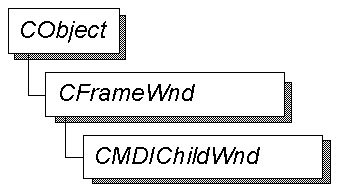class CMDIChildWnd : public CFrameWnd
 The CMDIChildWnd class provides the functionality of a Windows multiple document interface (MDI) child window, along with data and methods to manipulate the window. An MDI child window looks much like a typical application window, except that the MDI child window lacks a menu. The menu on the main application window applies to MDI child windows.
The CMDIChildWnd class provides the functionality of a Windows multiple document interface (MDI) child window, along with data and methods to manipulate the window. An MDI child window looks much like a typical application window, except that the MDI child window lacks a menu. The menu on the main application window applies to MDI child windows.
To create a useful MDI child window for your application, derive a class from CMDIChildWnd. Add member variables to the derived class to store data specific to your application. Implement message-handler member functions and a message map in the derived class to specify what happens when messages are directed to the window.
You create an MDI child window in two steps. First, call the constructor CMDIChildWnd to construct the CMDIChildWnd object, then call the Create member function to create the MDI child window and attach it to the CMDIChildWnd object.
Construction can be a one-step process in a derived class. Write a constructor for the derived class and call Create from within the constructor.
When the user terminates your MDI child window, destroy the CMDIChildWnd object, or call the DestroyWindow member function, which CMDIChildWnd inherits from class CWnd, to remove the CMDIChildWnd and destroy its data structures. If you allocate any memory in the CMDIChildWnd object, override the CMDIChildWnd destructor to dispose of the allocations.
See Also
CWnd, CFrameWnd, CMDIFrameWnd
 The CMDIChildWnd class provides the functionality of a Windows multiple document interface (MDI) child window, along with data and methods to manipulate the window. An MDI child window looks much like a typical application window, except that the MDI child window lacks a menu. The menu on the main application window applies to MDI child windows.
The CMDIChildWnd class provides the functionality of a Windows multiple document interface (MDI) child window, along with data and methods to manipulate the window. An MDI child window looks much like a typical application window, except that the MDI child window lacks a menu. The menu on the main application window applies to MDI child windows.